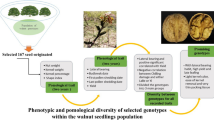Summary
Rye-derived wheat cultivars are being used in many breeding programmes throughout the world in order to achieve improvements in yield and disease resistance. However, the serious quality defect of intense dough stickiness associated with many of these wheat cultivars is limiting the usefulness of their flour in large mechanised bread bakeries. A dough preparation procedure was developed which enabled the dough surface properties of a range of rye-derived wheat cultivars to be assessed on doughs mixed quantitatively to their optimum mixing time. Intense dough stickiness was found in samples of 1AL/1RS and 1DL/1RS translocation lines tested and in all of the 1BL/1RS wheat cultivars examined except the West German cultivar, Disponent. Most of the 1BL/1RS wheat cultivars were derived from the Russian cultivars, Kavkaz, Aurora and Skorospelka 35 and included the CIMMYT-bred cultivars such as the Veery lines (Glennson, Ures, Genaro and Seri) and the Nebraskan cultivar, Siouxland. Based on the results of studying selected 1BL/1RS wheat cultivars in detail, this intense dough stickiness appeared to be independent of growing season, trial location, protein content, mixing tolerance, milling process and extraction rate. In addition pilot bakery trials confirmed that our laboratory testing procedures can be used to detect this intense dough stickiness.
Similar content being viewed by others
References
Anonymous, 1985. Annual Report, 1985. Bread Research Institute of Australia: Sydney.
Bartos, P.J. Valkoun, J. Kosner & V. Slovencikova 1973. Rust resistance of some European wheat cultivars derived from rye. In: Proc. 4th Int. Wheat Genet. Symp., Mo. Agric. Stn.: Columbia, MO, pp 145–146.
CIMMYT Wheat Staff, 1986. Veery ‘S’: Bread wheats for many environments CIMMYT, Mexico, D.F., Mexico.
CIMMYT, 1988. Breeding Strategies for Resistance to the Rusts of Wheat. CIMMYT, Mexico, D.F., Mexico.
Dhaliwal, A.S., D.J. Mares & D.R. Marshall, 1987. Effect of 1B/1R chromosome translocation on milling and quality characteristics of bread wheats. Cereal Chem. 64: 72–76.
Dhaliwal, A.S., D.J. Mares, D.R. Marshall & J.H. Skerritt, 1988. Protein composition and pentosan content in relation to dough stickiness of 1B/1R translocation wheats. Cereal Chem. 65: 143–149.
Hlynka, I. & J.A. Anderson, 1955. Laboratory dough mixer with an air-tight bowl. Cereal Chem. 32: 83–87.
Kilborn, R.H., 1979. Mixing curves and energy measurements in test baking. Bakers J. 39: 18–19, 39–41.
Kilborn, R.H. & K.H. Tipples, 1973. Factors affecting mechanical dough development III. Mechanical efficiency of laboratory dough mixers. Cereal Chem. 50: 50–69.
Martin, D.J. & B.G. Stewart, 1985. Variation in dough stickiness among wheats derived from rye. Chemistry in Australia 52: 313 (Abstract).
Martin, D.J. & B.G. Stewart, 1986. Dough mixing properties of a wheat-rye derived cultivar. Euphytica 35: 225–232.
Martin, D.J., B.G. Stewart & R.J. Mayer, 1986. Dough quality of Australian wheat cultivars as measured by the resistograph. Food Tech. in Aust. 38: 187–190.
Merker, A., 1982. ‘Veery’—a CIMMYT spring wheat with the 1B/1R chromosome translocation. Cer. Res. Comm. 10: 105–106.
Mettin, D., W.D. Bluthner & G. Schlegel, 1973. Additional evidence on spontaneous 1B/1R wheat-rye substitutions and translocations. In: Proc. 4th Int. Wheat Genet. Symp., Mo. Agric. Stn.: Columbia, MO, pp 179–184.
Rajaram, S., Ch. E Mann, G. Ortiz-Ferrara & A. Mujeeb-Kazi, 1983. Adaption, stability and high yield potential of certain 1B/1R CIMMYT wheats. In: Proc. 6th Int. Wheat Genet. Symp., Plant Germ-Plasm Inst., Kyoto Univ.: Kyoto, Japan, pp 613–621.
Schmidt, J.W., V.A. Johnson, P.J. Mattern, A.F. Dreier, D.V. McVey & J.H. Hatchett, 1985. Registration of ‘Siouxland’ wheat. Crop Sci 25: 1130–1131.
Symes, K.J., 1965. Inheritance of grain hardness as measured by the particle size index. Aust. J. Agric. Res. 16: 113–123.
Zeller, F.J., 1973. 1B/1R wheat-rye chromosome substitutions and translocations. In: Proc. 4th Int. Wheat Genet. Symp., Mo. Agric. Stn.: Columbia, MO, pp 209–221.
Zeller, F.J., 1973. 1B/1R wheat-rye chromosome substitutions and translocations. In: Proc. 4th Int. Wheat Genet. Symp., Mo. Agric. Stn.: Columbia, MO, pp 209–221.
Zeller, F.J., G. Gunzel, G. Fischbeck, P. Gerstenkorn & D. Weipert, 1982. Veranderungen der Backeigenschaften des Weizens durch die Weizen-Roggen-Chromosomentranslokation 1B/1R. Getreide, Mehl und Brot 36: 141–143.
Zeller, F.J. & E. Fuchs, 1983. Cytologie und Krankheitsresistenz einer 1A/1R-und mehrerer 1B/1R—Weizen—Roggen-Translokationssorten. Z. Pflanzenzuchtg 90: 285–296.
Zeller, F.J. & Sai L.K. Hsam, 1983. Broadening the genetic variability of cultivated wheat by utilizing rye chromatin. In: Proc. 6th Int. Wheat Genet. Symp., Plant Germ-Plasm Inst., Kyoto Uni.: Kyoto, Japan, pp 161–173.
Author information
Authors and Affiliations
Rights and permissions
About this article
Cite this article
Martin, D.J., Stewart, B.G. Dough stickiness in rye-derived wheat cultivars. Euphytica 51, 77–86 (1990). https://doi.org/10.1007/BF00022895
Received:
Accepted:
Issue Date:
DOI: https://doi.org/10.1007/BF00022895



